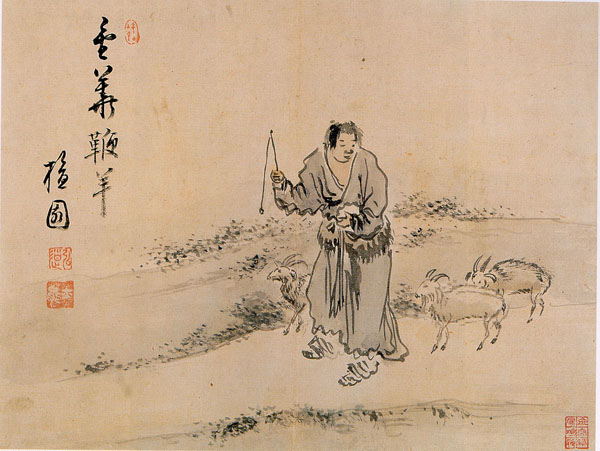In Korea, attitudes on sheep clouded in a mixed history

In “Geumhwapyeonyang” by Kim Hong-do (1745-unknown), a shepherd is portrayed as arighteous man. [JoongAng Ilbo]
Sheep have not been as prevalent in Korea as cows or pigs, ever since ancient times. For starters, the Korean Peninsula is mountainous and lacks grassland, meaning that it is not the best environment for raising the species.
Korea’s first encounter with sheep is believed to have occurred during the Goryeo Dynasty (918-1392) when they were brought into the country through China’s Jin Dynasty (1115-1234). There are records from the ensuing Joseon Dynasty (1392-1910) that say sheep were raised here, but due to reasons such as endemic diseases, the animals didn’t really prosper.
In fact, Koreans traditionally did not distinguish goats from sheep. In “Mokminsimseo,” Jeong Yak-yong (1762-1836) wrote that “there are no sheep in Joseon. Those raised at counties and prefectures are black sheep.”
By “black sheep,” Jeong meant goats.
Cheon Jin-gi, the director of the National Folk Museum of Korea, says that “compared to artifacts related to other animals like tigers and horses, there are few folk items related to sheep.” There are also few street names named after sheep, according to figures by the National Geographic Information Institute, compared to those with references to dragons or horses.
Still, just like in Western and Chinese myths, sheep and shepherds appear in Korean myths and traditional paintings, with shepherds often being portrayed as good.
In the painting “Geumhwapyeonyang” by Kim Hong-do (1745-unknown), 15-year-old shepherd Hwang Cho-pyeong is a virtuous and righteous man who is taken to the world of sinseon, or immortal beings who have magical powers, along with his sheep. He lives there with his animals, forever 15 years old.
BY PARK JUNG-HO [hkim@joongang.co.kr]










with the Korea JoongAng Daily
To write comments, please log in to one of the accounts.
Standards Board Policy (0/250자)